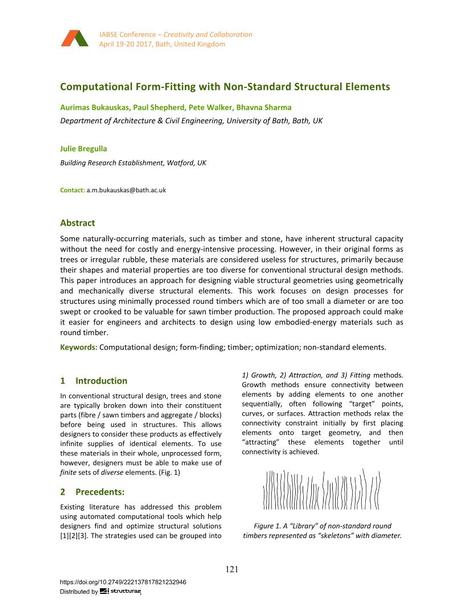Computational Form-Fitting with Non-Standard Structural Elements

| Author(s): |
Aurimas Bukauskas
(Department of Architecture & Civil Engineering, University of Bath, Bath, UK)
Paul Shepherd (Department of Architecture & Civil Engineering, University of Bath, Bath, UK) Pete Walker (Department of Architecture & Civil Engineering, University of Bath, Bath, UK) Bhavna Sharma (Department of Architecture & Civil Engineering, University of Bath, Bath, UK) Julie Bregulla (Building Research Establishment, Watford, UK) |
|---|---|
| Medium: | conference paper |
| Language(s): | English |
| Conference: | IABSE Conference: Creativity and Collaboration – Instilling Imagination and Innovation in Structural Design, Bath, United Kingdom, 19-20 April 2017 |
| Published in: | IABSE Conference Bath, April 19-20, 2017 |
| Page(s): | 121-122 |
| Year: | 2017 |
| DOI: | 10.2749/222137817821232946 |
| Abstract: |
Some naturally-occurring materials, such as timber and stone, have inherent structural capacity without the need for costly and energy-intensive processing. However, in their original forms as trees or irregular rubble, these materials are considered useless for structures, primarily because their shapes and material properties are too diverse for conventional structural design methods. This paper introduces an approach for designing viable structural geometries using geometrically and mechanically diverse structural elements. This work focuses on design processes for structures using minimally processed round timbers which are of too small a diameter or are too swept or crooked to be valuable for sawn timber production. The proposed approach could make it easier for engineers and architects to design using low embodied-energy materials such as round timber. |
| Keywords: |
optimization timber form-finding computational design non-standard elements
|
0.14 MB
- About this
data sheet - Reference-ID
10292757 - Published on:
27/01/2019 - Last updated on:
21/05/2021



